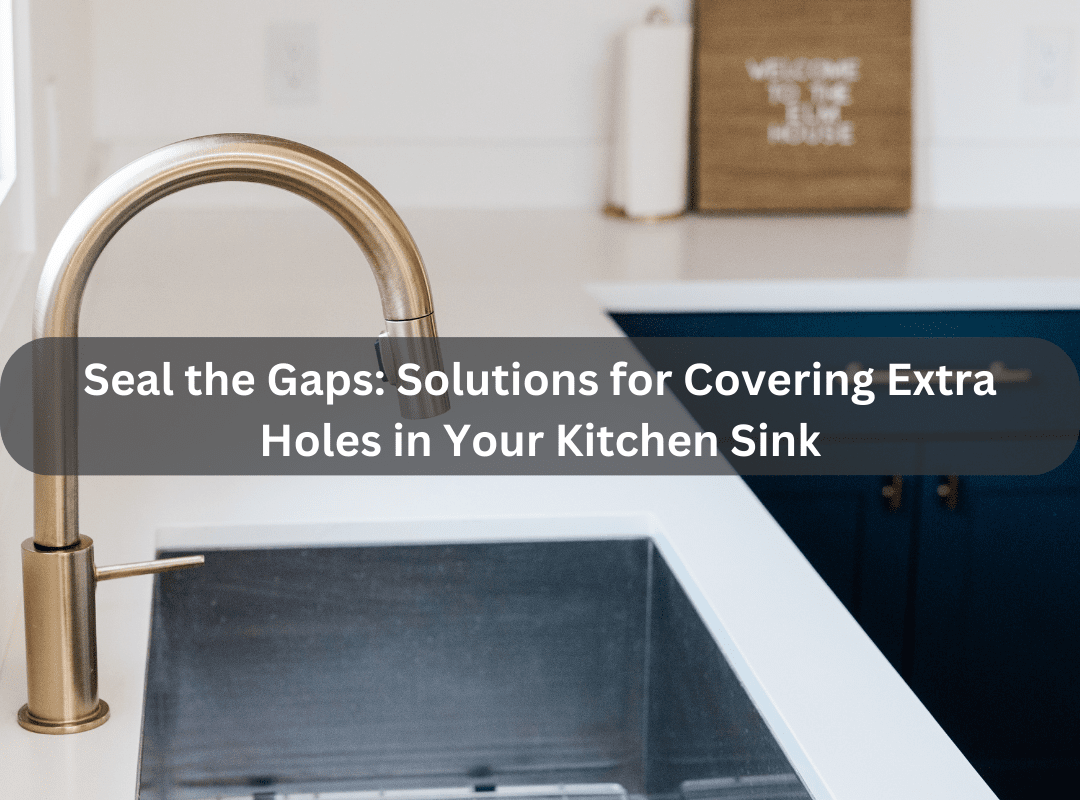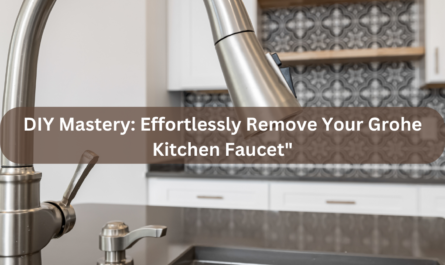Introduction For How To Cover Extra Holes In Kitchen Sink
Covering extra holes in a kitchen sink is a common task encountered when updating or replacing sink fixtures. Whether you’ve removed an old faucet, soap dispenser, or sprayer, or simply have unused holes from the original sink installation, covering these openings is essential for both aesthetic and practical reasons. Fortunately, with the right tools and techniques, covering extra holes in a kitchen sink can be a straightforward process. In this guide, we’ll explore various methods and considerations for effectively covering extra holes, ensuring a seamless and functional finish that enhances the appearance and usability of your kitchen sink.
Assess the size and shape of the extra holes
When assessing the size and shape of the extra holes in your kitchen sink, you want to determine their dimensions and overall form. Here’s what it means:
Size: Consider whether the hole is relatively small or large. Small holes are typically those that are around the size of a pencil eraser or smaller, while larger holes may be closer to the size of a quarter or even larger. Understanding the size helps you choose an appropriate cover that will effectively conceal the hole without leaving any gaps around the edges.
Shape: Determine whether the hole is round or has an irregular shape. Most kitchen sink holes are circular, especially those intended for accessories like faucets or soap dispensers. However, in some cases, the hole may be irregularly shaped due to modifications or damage. Knowing the shape helps you select a cover that matches the contours of the hole for a proper fit and seamless appearance.
Purchase a sink hole cover
When you’re in the market for a sink hole cover to conceal extra holes in your kitchen sink, you should seek out products that are explicitly designed for this purpose. Here’s an explanation:
Specific Design: Sink hole covers designed for kitchen sinks are crafted to fit over the standard-sized holes typically found in sink fixtures, such as faucets, sprayers, or soap dispensers. These covers are manufactured to provide a snug and secure fit, ensuring that the extra holes are effectively concealed.
Variety of Sizes: Sink hole covers are available in a range of sizes to accommodate different hole diameters commonly found in kitchen sinks. This variety allows you to select a cover that matches the specific dimensions of the extra hole you need to cover, ensuring a seamless and aesthetically pleasing result.
Materials: Sink hole covers are crafted from various materials, including stainless steel, plastic, rubber, or composite materials. These materials are chosen for their durability, water resistance, and ability to withstand the conditions of a kitchen environment. Additionally, the diverse material options enable you to select a cover that complements the design and finish of your sink.
Measure the diameter of the hole
Selecting the Right Size Cover: By using a measuring tape or ruler to measure the diameter of the hole, you ensure that you choose a sink hole cover that fits the size of the opening properly. The diameter measurement helps you select a cover that matches the width of the hole, ensuring a snug and secure fit.
Accurate Sizing: Measuring the diameter accurately is essential to prevent gaps between the cover and the edges of the hole. If the cover is too small, it may not fully conceal the opening, while a cover that is too large may not fit properly or may appear disproportionate to the sink.
Preventing Leaks: A properly sized cover creates a tight seal around the hole, minimizing the risk of water leakage. Ensuring a precise fit helps maintain the integrity of the sink and prevents water from seeping through the uncovered hole, which could potentially cause damage to the surrounding area.
Ease of Installation: Knowing the diameter of the hole beforehand simplifies the process of selecting and installing the sink hole cover. You can confidently choose a cover that matches the measured diameter, minimizing the need for adjustments during installation and ensuring a seamless finish.
Choose the appropriate material
Durability: Different materials offer varying levels of durability. Stainless steel, for example, is known for its strength and resistance to corrosion, making it a long-lasting option. Plastic and rubber covers are also durable and resistant to water damage, although they may not be as robust as stainless steel.
Functionality: Consider how the material will perform in a kitchen environment. Stainless steel covers are easy to clean and maintain, making them ideal for high-traffic areas like the kitchen. Plastic and rubber covers are also easy to clean and typically resistant to stains and odors, making them suitable for use in sinks where food preparation and dishwashing occur.
Aesthetic Preferences: The material of the sink hole cover can impact the overall look and feel of your kitchen sink area. Stainless steel covers offer a sleek and modern appearance, while plastic and rubber covers may have a more subtle or understated look. Choose a material that complements the design and style of your kitchen sink for a cohesive aesthetic.
Compatibility: Consider any specific requirements or features of your sink when selecting a cover material. For example, if your sink is made of a particular material such as ceramic or granite, choose a cover material that complements or matches it. Additionally, ensure that the material is compatible with any accessories or fixtures installed in the sink, such as faucets or soap dispensers.
Clean the area around the hole
Removing Debris: Over time, dirt, grime, and other debris can accumulate around the edges of the hole in your kitchen sink. Cleaning the area thoroughly with a clean cloth helps to remove any loose particles that could interfere with the installation process or prevent the sink hole cover from sealing properly.
Ensuring a Smooth Surface: By wiping the area around the hole, you create a clean and smooth surface for the sink hole cover to adhere to. This helps to prevent any bumps or irregularities that could cause the cover to sit unevenly or create gaps, which may lead to water leakage.
Improving Adhesion: A clean surface allows for better adhesion between the sink hole cover and the sink itself. This is particularly important if you’re using any sealant or adhesive during the installation process. A clean surface ensures that the sealant can bond effectively, providing a watertight seal and preventing leaks.
Enhancing Aesthetic Appearance: Cleaning the area around the hole also improves the overall aesthetic appearance of your kitchen sink. Removing dirt and residue ensures that the sink hole cover sits flush against the surface of the sink, giving it a seamless and polished look.
Insert the cover into the hole
Concealing the Hole: The primary purpose of inserting the cover into the hole is to effectively conceal the extra opening in your sink. This helps to maintain the aesthetic integrity of the sink area by creating a seamless and polished appearance.
Preventing Water Leakage: By pressing the cover firmly into place, you ensure that it forms a tight seal with the sink surface. This helps to prevent water from leaking through the uncovered hole during everyday use, minimizing the risk of water damage to the surrounding area.
Ensuring Stability: Properly inserting the cover into the hole ensures that it remains securely in place over time. This is particularly important in high-traffic kitchen environments where the sink may be subjected to frequent use. A securely positioned cover will not shift or become dislodged during normal activities such as washing dishes or cleaning the sink.
Enhancing Safety: A securely installed sink hole cover reduces the risk of accidents or injuries that could occur if someone inadvertently catches their fingers or utensils in the uncovered hole. By ensuring that the cover sits flush with the sink surface, you create a safer environment for yourself and others using the sink.
Ensure a tight seal
Preventing Water Damage: A tight seal created by the sink hole cover is essential for keeping water from seeping through the uncovered hole. Without a proper seal, water can leak into the cabinet below the sink, leading to damage such as mold growth, wood rot, or damage to stored items.
Maintaining Hygiene: Water leakage through the hole can also create a breeding ground for bacteria and mold, compromising the cleanliness of your kitchen sink area. By ensuring a tight seal, you help maintain a hygienic environment and reduce the risk of contamination.
Preserving Sink Integrity: Water leakage can potentially weaken the structure of the sink and surrounding materials over time. By preventing leaks with a tight seal, you help preserve the integrity of the sink, prolonging its lifespan and reducing the need for costly repairs or replacements.
Improving Efficiency: A tight seal ensures that water flows efficiently down the drain rather than leaking out through uncovered holes. This helps optimize the functionality of your kitchen sink and minimizes water wastage.
Apply sealant (optional)
Enhanced Waterproofing: Sealant creates a watertight barrier between the edges of the sink hole cover and the surrounding sink surface. This additional layer of protection helps to prevent any potential gaps or imperfections from allowing water to seep through, further reducing the risk of leaks.
Increased Durability: Sealant can help reinforce the bond between the sink hole cover and the sink surface, making it less likely for the cover to shift or become dislodged over time. This added stability enhances the durability of the installation, ensuring long-lasting performance.
Protection Against Moisture: In areas prone to high levels of moisture, such as around kitchen sinks, sealant helps to protect against water damage by sealing off any vulnerable areas where water could penetrate. This can help prevent issues such as mold growth, rotting, or deterioration of the sink material.
Improved Aesthetic Appearance: Sealant can also create a smooth and seamless transition between the sink hole cover and the surrounding sink surface, enhancing the overall aesthetic appearance of the installation. This can result in a more polished and professional-looking finish.
When applying sealant, be sure to choose a waterproof sealant suitable for use in kitchen environments. Follow the manufacturer’s instructions for proper application, allowing adequate drying time before using the sink. Additionally, ensure that the sealant does not interfere with the functionality of any accessories or fixtures installed in the sink, such as faucets or soap dispensers.
Allow the sealant to dry (if applicable)
Ensuring Proper Adhesion: Allowing the sealant to dry according to the manufacturer’s instructions ensures that it has sufficient time to cure and form a strong bond with both the sink hole cover and the surrounding sink surface. This promotes optimal adhesion and helps prevent the sealant from peeling or cracking prematurely.
Preventing Leaks: Proper drying of the sealant is essential for ensuring its effectiveness in creating a watertight seal around the edges of the sink hole cover. If the sealant is not allowed to dry completely before using the sink, it may not provide adequate protection against leaks, compromising the integrity of the installation.
Avoiding Damage: Using the sink before the sealant has fully dried can disrupt the curing process and potentially damage the sealant. This may lead to gaps or weaknesses in the seal, increasing the risk of water leakage and necessitating reapplication of the sealant.
Following Manufacturer’s Instructions: Different types of sealants have varying drying times, depending on factors such as temperature, humidity, and thickness of application. Following the manufacturer’s instructions ensures that you allow the sealant ample time to dry properly, maximizing its effectiveness and durability.
Test for leaks
Ensuring Proper Functionality: Running water over the covered hole allows you to simulate normal usage of the sink and assess whether the sink hole cover effectively prevents water from leaking through. This ensures that the cover is functioning as intended and provides the necessary protection against leaks.
Identifying Potential Issues: Testing for leaks helps you identify any potential gaps, weaknesses, or defects in the installation or sealant application. If water is observed leaking through the covered hole, it indicates that adjustments may be needed to achieve a proper seal and prevent future leaks.
Preventing Water Damage: Identifying and addressing leaks promptly helps prevent water from seeping into the cabinet below the sink or causing damage to surrounding fixtures and materials. By conducting a leak test, you can mitigate the risk of costly water damage repairs and maintain the integrity of your kitchen sink area.
Ensuring Safety and Hygiene: A leak-free sink hole cover promotes safety by preventing water from accumulating in the cabinet below the sink, which could create slippery conditions or harbor bacteria and mold growth. This helps maintain a clean, hygienic, and hazard-free environment in your kitchen.
Trim excess material (if needed)
Enhancing Aesthetic Appeal: Excess material protruding from the edges of the sink hole cover can detract from the overall appearance of the sink area. Trimming this excess material creates a cleaner and more polished look, contributing to the overall aesthetic appeal of the kitchen sink.
Improving Fit and Functionality: In some cases, excess material may interfere with the proper fit of the sink hole cover, preventing it from sitting flush against the sink surface. Trimming away this excess material helps to ensure a snug and secure fit, improving the functionality of the cover and reducing the risk of water leakage.
Preventing Obstruction: Excess material around the edges of the sink hole cover can also pose a potential obstruction, making it more difficult to clean the sink or interfering with the installation of other accessories or fixtures. Trimming away this excess material eliminates these obstructions, making maintenance and usage of the sink more convenient.
Achieving a Professional Finish: Trimming excess material from the sink hole cover allows you to achieve a professional-looking finish that enhances the overall appearance of the sink area. This attention to detail demonstrates care and precision in the installation process, resulting in a more aesthetically pleasing result.
Consider decorative options
Personalization: Opting for a decorative sink hole cover gives you the opportunity to express your personal style and taste in your kitchen design. With various designs, patterns, and finishes available, you can choose a cover that resonates with your preferences and complements the overall theme of your kitchen decor.
Enhanced Aesthetics: Decorative sink hole covers can serve as stylish accents that elevate the visual appeal of your kitchen sink area. Whether you prefer classic elegance, modern sophistication, or whimsical charm, there are decorative options available to suit a wide range of design aesthetics.
Coordination with Decor: By selecting a sink hole cover with decorative elements, you can coordinate it with other design elements in your kitchen, such as cabinet hardware, faucet finishes, or backsplash tiles. This creates a cohesive and harmonious look throughout the space, enhancing the overall ambiance of your kitchen.
Conversation Starter: A unique and eye-catching sink hole cover can serve as a conversation starter when entertaining guests in your home. Whether it features intricate detailing, bold colors, or novelty motifs, a decorative cover adds personality and character to your kitchen, making it a memorable focal point for visitors.
Versatility: Decorative sink hole covers come in a variety of materials and styles, allowing you to choose an option that best suits your preferences and functional needs. Whether you prefer a cover made of stainless steel, ceramic, or colorful enamel, there are decorative options available to suit every taste and kitchen design.
Check for compatibility with accessories
Maintaining Functionality: Additional features like sprayers or soap dispensers are installed in specific locations on the sink for practical purposes. Ensuring that the sink hole cover does not interfere with these features allows you to maintain their functionality and accessibility. This ensures that you can continue to use these accessories effectively without any hindrance.
Preventing Obstruction: Placing a sink hole cover that obstructs the path of a sprayer or soap dispenser can make it difficult or impossible to use these accessories properly. This can be inconvenient and frustrating during daily kitchen tasks such as washing dishes or cleaning surfaces. Checking for compatibility ensures that the sink cover does not impede the movement or operation of these accessories.
Avoiding Damage: Incompatibility between the sink hole cover and additional accessories can potentially cause damage to either the cover or the accessory. For example, if the cover presses against a soap dispenser or sprayer, it may cause misalignment, leaks, or even breakage. Checking for compatibility helps prevent such damage and ensures the longevity of both the cover and the accessories.
Enhancing Convenience: A sink hole cover that is compatible with existing accessories enhances the overall convenience and functionality of the kitchen sink area. It allows you to seamlessly switch between using the sink with or without the cover while still having access to essential features like the sprayer or soap dispenser, as needed.
Seek professional assistance
Expertise and Experience: Professional plumbers have the knowledge, skills, and experience necessary to assess the situation accurately and determine the most appropriate course of action. They can provide expert advice and guidance based on their extensive training and practical experience in handling various plumbing issues, including sink installations and repairs.
Problem Identification: If you encounter any difficulties or complications during the installation process, a professional plumber can help identify the underlying issues and propose effective solutions. They can troubleshoot potential problems, such as leaks, improper fit, or compatibility issues, and recommend appropriate remedies to address them promptly.
Ensuring Proper Installation: Installing a sink hole cover correctly is essential for maintaining the integrity of your kitchen sink and preventing potential problems such as leaks or damage. A professional plumber can ensure that the cover is installed properly, with a tight seal and proper alignment, to optimize its effectiveness and longevity.
Minimizing Risks: Attempting to tackle plumbing tasks without the necessary expertise and tools can pose risks, both to your safety and to the integrity of your plumbing system. By consulting a professional plumber, you can minimize the risk of accidents, injuries, and costly mistakes that could arise from DIY attempts.
Compliance with Regulations: Professional plumbers are familiar with local building codes and regulations governing plumbing installations. They can ensure that the installation of the sink hole cover complies with applicable codes and standards, providing you with peace of mind and avoiding potential legal or regulatory issues down the line.
Saving Time and Effort: Hiring a professional plumber saves you the time and effort of trying to figure out complex plumbing tasks on your own. They can complete the installation efficiently and effectively, allowing you to focus on other priorities without the hassle of DIY troubleshooting.
Q1: How can I cover extra holes in my kitchen sink?
A1: Utilize hole covers, also known as sink hole covers, to conceal extra holes in the sink.
Q2: What are hole covers, and how do they work?
A2: Hole covers are metal or plastic discs designed to fit into unused faucet or accessory holes, effectively covering them to create a seamless look.
Q3: Where can I find hole covers for my kitchen sink?
A3: Hardware stores, home improvement centers, and online retailers offer a variety of hole covers designed for kitchen sinks.
Q4: How do I choose the right size of hole cover for my sink?
A4: Measure the diameter of the extra hole and select a hole cover with a size that matches or slightly exceeds the hole diameter.
Q5: Can I use something other than hole covers to conceal extra holes?
A5: Yes, alternatives include using decorative caps or plates, but hole covers are specifically designed for this purpose and offer a clean, finished look.
Q6: Are hole covers easy to install?
A6: Yes, most hole covers have a simple installation process. They typically consist of a threaded shank that screws into the existing hole.
Q7: Do hole covers work for any type of kitchen sink?
A7: Yes, hole covers are versatile and can be used with various sink materials, including stainless steel, cast iron, and composite.
Q8: Can I install hole covers without professional assistance?
A8: Yes, hole covers are designed for DIY installation and usually come with straightforward instructions.
Q9: Are there decorative options for hole covers?
A9: Yes, there are decorative hole covers available in various finishes, allowing you to coordinate with your faucet or kitchen decor.
Q10: How do I remove a hole cover if needed?
A10: Unscrew the hole cover by turning it counterclockwise, and it should come off easily. Use pliers if it’s tight.
Q11: Can hole covers be used in sinks with pre-drilled holes for accessories?
A11: Yes, hole covers are versatile enough to cover any unused holes, whether originally intended for accessories or not.
Q12: Do hole covers affect the functionality of the sink?
A12: No, hole covers do not impact the functionality of the sink; they simply provide a cosmetic solution for unused holes.
Q13: Can I use a hole cover for a hole that is close to the edge of the sink?
A13: Yes, as long as the hole cover is properly secured, it can be used for holes near the sink’s edge.
Q14: Are there waterproof options for covering sink holes?
A14: Yes, hole covers are designed to be waterproof, preventing water from seeping into the unused holes.
Q15: Can hole covers be painted to match the sink color?
A15: Some hole covers can be painted with the appropriate type of paint to match the sink color, but it’s essential to follow the manufacturer’s recommendations.
Q16: How do I maintain hole covers?
A16: Hole covers require minimal maintenance. Periodically check for any loosening and ensure they remain securely fastened.
Q17: Are there alternatives to hole covers for concealing sink holes?
A17: While hole covers are a common and effective solution, other options include using a soap dispenser or a second faucet for a stylish and functional approach.
Q18: Can I use a temporary solution to cover sink holes?
A18: Yes, if you need a temporary solution, you can use items like tape or rubber stoppers to cover the holes temporarily until a more permanent solution is applied.
Q19: Do hole covers work for all types of faucet holes?
A19: Yes, hole covers are designed to cover various types of faucet holes, including those intended for single-handle, double-handle, or touchless faucets.
Q20: Can hole covers be used for bathroom sinks as well?
A20: Yes, hole covers are versatile and can be used to conceal extra holes in bathroom sinks, providing a clean and finished appearance.
Conclusion On How To Cover Extra Holes In Kitchen Sink
As we conclude our exploration into the world of covering extra holes in the kitchen sink, envision a space where every detail aligns with precision. The once-disruptive holes are now gracefully concealed, creating a canvas that not only satisfies functional needs but also elevates the visual appeal of your culinary haven.
Whether you opt for sleek hole covers or get creative with decorative alternatives, the result is a kitchen sink that resonates with a newfound elegance. Here’s to a kitchen where every note, no matter how small, contributes to the symphony of a well-designed and aesthetically pleasing culinary space.




